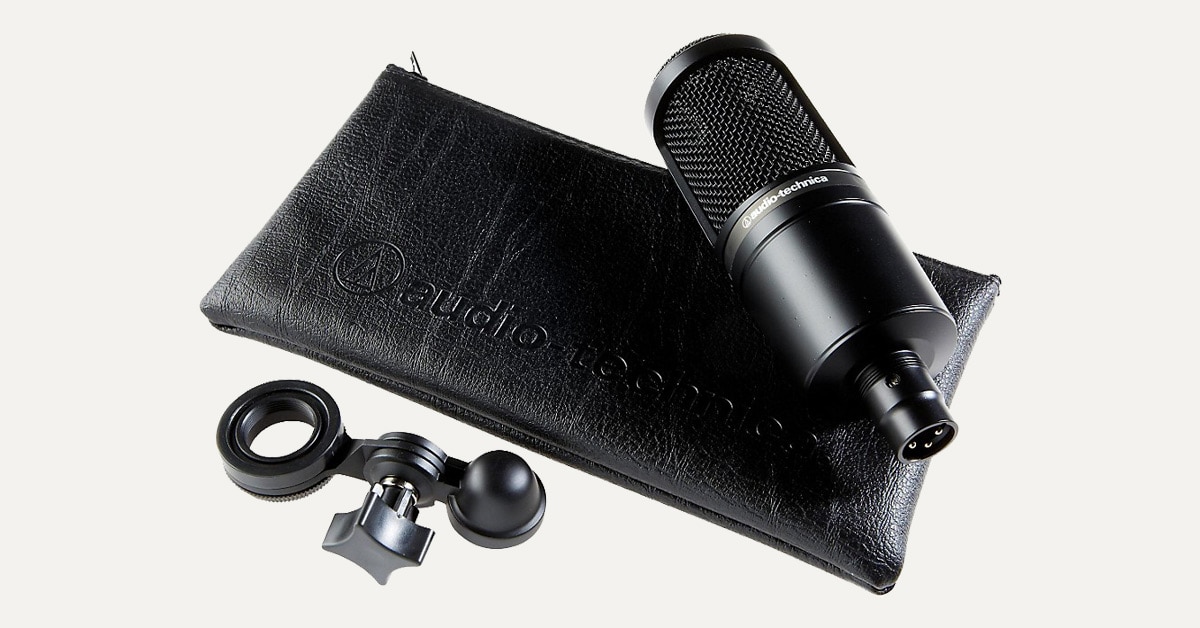Written By Dan Sherman
I'm here to recommend the Audio-Technica AT2020 as a fantastic microphone for the home or project studio. Who am I? I'm no expert recording engineer. I'm just a guy who has a band to record, songs in his head, and a bad case of home recording fever. I'm learning fast, however, and one thing I've learned is that the AT2020 is a perfect mic for home recording on a budget.
Money issues
When I decided to get set up so I could record both the songs I'm writing and my band's stuff, I bought all the big gear first. I chose a 16-track desktop studio instead of an eight-track as I had originally planned. I went a step higher than I should have on reference monitors. By the time I got around to thinking about microphones, I was just about tapped out.
I didn't want to spend any money on a funky microphone. Nor did I want to rely on borrowed mics. I wanted my own so I would be ready to record any time I felt creative. It looked like I would be stuck using my stage mics until I caught up with my bills and saved some more money. I was resigned to this course when a friend told me about the mic he was using, an AT2020 from Audio-Technica. He sung its praises for awhile and I was getting envious. Then when he told me what he had paid for it, I was interested.
Spectacular specs
I liked the AT2020 from the moment I took it out of its shipping container-hefty with a well-built look and feel. It is a side-address condenser cardioid with an extended frequency range of 20Hz-20kHz. This extended range makes it capable of recording low- and high-register instruments with equal grace.
It rates a whoppin' 144dB maximum SPL, which means it can handle the really loud stuff. It also has a good sensitivity rating so it can handle the soft and delicate side, too. Another great quality is its low self-noise which makes it suited for digital recording-exactly what I planned to use it for.
The diaphragm is 16mm across, a middle-of-the-road size-bigger than a small-diaphragm condenser and a little smaller than a large-diaphragm condenser-which to me speaks to its being a good all-purpose microphone. Versatility is a must when you only have one microphone.
Test drives
I couldn't wait to hook it up and see what it could do. The first thing I tried was a vocal part over some tracks I had already laid down. When I finished I compared it to a parallel track I had previously made with the dynamic mic I use onstage. The difference was profound. Same singer, same song, but the AT2020 captured so much more of my voice. I've always thought that my recorded voice sounded thin, but the AT2020 fattened it up and added detail. During mixing, the tone controls seem to do more, probably because they had more information to work with.
Over a week or so, I tried the AT2020 on horns (tenor sax and trombone) and on a variety of percussion instruments with great success. Though I had always used the guitar input on the desktop studio and its cab emulation, I tried miking my guitar amp. Using the little Gibson Skylark that I love because of its righteous tone, the AT2020 captured the sound perfectly, even when I got ripping loud.
Another way I used the AT2020 was as an overhead for the drum kit's cymbals while using the drummer's stage mikes for the rest of the kit. It worked all right for this application too. I think a small condenser with a wider pattern might do a better job, but the AT2020 does it well enough to suffice until I can afford to extend my microphone choices.
In conclusion, I'm really happy with the AT2020, both with the way it performs and with its low price. If you're into home recording and trying to get set up without spending too much, take a look at the AT2020. In my book, it's an exceptional all-purpose microphone that's priced to make it one of the best deals out there.






































































































































